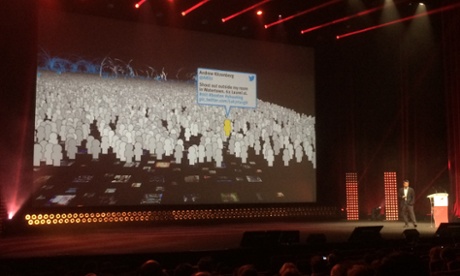
Twitter’s chief media scientist Deb Roy has staked the social network’s claim to be a better partner for broadcasters, TV producers and advertisers than rival Facebook.
“The biggest, most pervasive medium ever invented – television – is being intertwined with a global social medium, Twitter,” said Roy. “Twitter makes television better: it is in fact a force multiplier that can enhance the impact and possibilities of television.”
Roy was speaking in a keynote speech at the MIPTV television industry conference in Cannes, in a presentation focusing heavily on data visualisations to show how chatter about TV shows and ads spreads on Twitter.
“It’s live, it’s public and it’s conversational. We use it in the moment to talk to everyone who cares to listen. And we use it to converse: to exchange words,” he said. “A synchronised social soundtrack for whatever is happening in the moment, as a shared experience.”
Roy claimed that the growing number of TV viewers who are simultaneously using Twitter on their smartphones or tablets are not necessarily distracted from shows. The “social soundtrack” argument compares Twitter buzz to the impact that actual soundtracks had on films after the silent era.
“It’s hard to imagine today what E.T. would have been like without the soundtrack,” said Roy. “Jaws, without the soundtrack was a silly robotic fish splashing around in the water!”
Roy gave some examples of TV shows and events that have sparked conversation on Twitter, including this year’s Oscars awards, when more than 5m people sent 19m tweets that were seen by 37m people.
“If you count up over a 48-hour window, the number of tweet impressions delivered in that extended window exceeded 3bn,” said Roy. “The scale here is obviously significant.”
Twitter is working with research firms like Nielsen to pursue a twin strategy of wooing broadcasters with data indicating that Twitter buzz around a show can persuade more people to tune in, while trying to convince brands that if they advertise around “highly social” shows, they’ll get a better return on their investment.
“A couple of hundred million dollars spent on TV advertising, by paying attention to where the social signal is from, it actually has bottom-line effects,” said Roy. “No matter how you slice it, the complementary activity of having Twitter active with television seems to be leading to positive outcomes from the advertiser point of view.”
Besides Nielsen, Twitter is working with Video Research, GfK and Kantar Media in various countries around the world to track tweets about TV and produce the equivalent of ratings charts, ranking shows by their social activity on Twitter.
The challenge for the TV industry is that Facebook has also been making concerted efforts to pitch its own merits as a social TV platform. While they share some features – hashtags, for example, which Facebook adopted in 2013 after seeing their appeal on Twitter – their efforts to provide data to broadcasters and brands are isolated from one another: Twitter-only ratings charts, for example.
Most TV firms will likely want to use data from both Twitter and Facebook, but Roy's unflattering comparison of Twitter's public chatter to the conversation on "your private social network" – a clear reference to Facebook – suggests that the competition will continue.
Twitter has also acquired social TV analytics startups like Trendrr, Bluefin Labs and SecondSync, some of which had been trying to help the TV industry make sense of data from both Twitter and Facebook.
In his speech, Roy also pitched Twitter as a broadcaster in its own right, citing its Amplify feature – which helps broadcasters to tweet short video clips of what’s just happened in a live show, complete with a pre-roll ad – as an example of Twitter as “a broadcast network that augments traditional broadcast”.
He also challenged TV producers to spend more time thinking about how Twitter as a social layer on top of their shows might help them develop new formats and features.
“I actually think the real puzzle in social TV and what’s happening with Twitter and television comes down to storytelling,” said Roy. “The challenge and the opportunity is in the hands of storytellers in how to tap into this new creative storytelling… to look to the data, and to really go and pioneer potentially whole new genres.”

